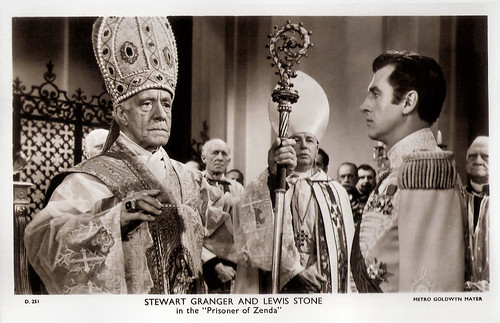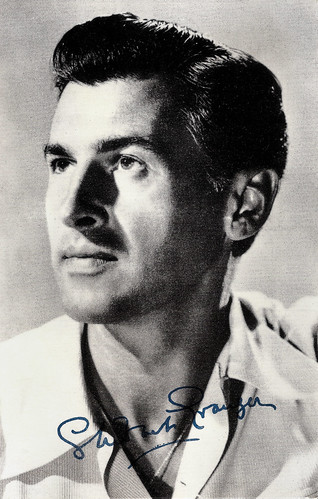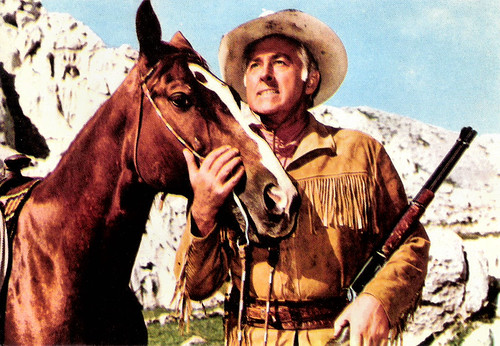
German postcard by Wilhelm Schulze-Witteborg, Wanne-Eickel. Photo: Metro Goldwyn Mayer.

Vintage photo. Photo: Metro-Goldwyn-Mayer. Stewart Granger and James Mason (left) in The Prisoner of Zenda (Richard Thorpe, 1952).

Austrian postcard by Verlag Hubmann (HDH), Wien, no. 102. Photo: Columbia. Stewart Granger in Salome (William Dieterle, 1953).

Vintage postcard.

German postcard by ISV, no. C 3. Photo: Constantin. Stewart Granger as Old Surehand in Unter Geiern/Among Vultures (Alfred Vohrer, 1964).
Jimmy Stewart
Stewart Granger was born as James Lablache Stewart in London in 1913 He was the only son of Major James Stewart, OBE, and his wife Frederica Eliza née Lablache, and the grandson of the actor Luigi Lablache.
He was educated at Epsom College and the Webber Douglas Academy of Dramatic Art. He changed his name to avoid confusion with Hollywood star James Stewart. Granger was his Scottish grandmother's maiden name.
In 1933, he made his film debut as an extra in A Southern Maid (Harry Hughes, 1933) and by 1935 he made his stage debut in 'The Cardinal at Hull'. He was with the Birmingham Repertory Company between 1936 and 1937, and in 1938 he made his West End debut in 'The Sun Never Sets'.
He had been gradually rising through the ranks of better stage roles when WW II began, and he joined the British Army in 1940. However, he was eventually disabled in 1942, which brought his release from military service.

British postcard. Photo: Gainsborough. Stewart Granger in Caravan (Arthur Crabtree, 1946).

British Postcard, nr. F.S. 31. Publicity card for Saraband for Dead Lovers (Basil Dearden, 1948).

Dutch postcard by Takken, Utrecht, nr. 401.

British postcard in the Greetings Series, Photo: MGM. (Metro-Goldwyn-Mayer).

With Jean Simmons. Vintage postcard. Photo: MGM.
Dashing Hero Type
With a dearth of leading men for British films, Stewart Granger quickly landed The Man in Grey (Leslie Arliss, 1943). This was the first installment of Gainsborough’s successful series of costume melodramas.
His first starring role made him overnight a star in Britain. Next, he starred in films like Madonna of the Seven Moons (Arthur Crabtree, 1943) with Phyllis Calvert, but the film work was unsatisfying.
He was often cast as the dashing hero type, while fellow up-and-coming actor James Mason always garnered the more substantial Gainsborough part. When Mason left for Hollywood, Granger inherited better parts in films like Caesar and Cleopatra (Gabriel Pascal, 1945) and Saraband for Dead Lovers (Basil Dearden, 1948).
Granger first met the very young Jean Simmons when they both worked on Caesar and Cleopatra (1945). Three years on, Simmons had transformed from a promising newcomer into a star - and a very attractive woman.
They married in 1950 in a bizarre wedding ceremony organised by Howard Hughes - one of his private planes flew the couple to Tucson, Arizona, where they were married, mainly among strangers, with Michael Wilding as Granger's best man. Then, Granger and Simmons both moved to Hollywood.

British postcard in the Picturegoer Series, London, no. D. 251. Photo: Metro-Goldwyn-Mayer. Stewart Granger and Lewis Stone (left) in The Prisoner of Zenda (Richard Thorpe, 1952).

British postcard on the Picturegoer Series, London, no. D 252. Photo: Metro-Goldwyn-Mayer. Stewart Granger and Deborah Kerr in The Prisoner of Zenda (Richard Thorpe, 1952).

British postcard in the Picturegoer series, no. D. 324. Photo: Metro Goldwyn Mayer (MGM). Publicity still for Young Bess (George Sidney, 1953) with Jean Simmons.

British postcard in the Picturegoer series, no. D. 320. Photo: Metro Goldwyn Mayer (MGM). Publicity still for Young Bess (George Sidney, 1953) with Guy Rolfe, Kathleen Byron, and Rex Thompson.

British postcard in the Film Star Autograph Portrait Series, by L.D. LTD., London, no. 122. Photo: M.G.M. Stewart Granger in Young Bess (George Sidney, 1953).
Swashbuckler
MGM had invited Stewart Granger to play Rider Haggard's hero Allan Quatermain in a film version of King Solomon's Mines (Compton Bennett, Andrew Morton, 1950) with Deborah Kerr. On the basis of the huge success of this film, he was offered a seven-year contract by MGM.
His theatrical voice, stature, and dignified profile made him a natural heir to Errol Flynn as a swashbuckler in the popular remakes of The Prisoner of Zenda (Richard Thorpe, 1952) and Scaramouche (George Sidney, 1952), and in Moonfleet (Fritz Lang, 1955).
The audience loved those romantic roles, but he found them still unsatisfying. He and Jean Simmons were paired in Young Bess (George Sidney, 1953), where Granger had the romantic lead, but Simmons was the focus of the film. That sort of undeclared competition was poison to their marriage.
They also co-starred in the underrated 'Victorian' thriller, Footsteps in the Fog (Arthur Lubin, 1955). In 1960 they divorced. That year Granger starred with John Wayne in the comic Western North to Alaska (Henry Hathaway, 1960). It would be the last Hollywood film he made.

Vintage postcard. Photo: Columbia. Charles Laughton, Rita Hayworth, and Stewart Granger in Salome (William Dieterle, 1953).

Spanish postcard. Photo: Columbia. Rita Hayworth, and Stewart Granger in Salome (William Dieterle, 1953).

French postcard by Editions du Globe, no. 512. Photo: M.G.M. (Metro-Goldwyn-Mayer). Stewart Granger in Moonfleet (Fritz Lang, 1955).

Small Romanian collectors card. Stewart Granger and Capucine in North to Alaska (Henry Hathaway, 1960).
Old Surehand
In Italy, Stewart Granger appeared in a comic pastiche on The Longest Day, Il giorno più corto/The Shortest Day (Sergio Corbucci, 1962), and in another good war film, Marcia o crepa/Commando (Frank Wisbar, 1962).
In Germany, he played Old Surehand next to Pierre Brice’s Winnetou in three Karl May Westerns, Unter Geiern/Among Vultures (Alfred Vohrer, 1964), Der Ölprinz/Rampage at Apache Wells (Harald Philipp, 1965), and Old Surehand/Flaming Frontier (Alfred Vohrer, 1965).
In the Edgar Wallace film series of the 1960s, he was seen in The Trygon Factor (Cyril Frankel, 1966).
His film career declined in the 1970s, and he later worked mainly for American television. One of his last roles was as Prince Philip in the TV film The Royal Romance of Charles and Diana (Peter Levin, 1982). Towards the end of his career, Granger even starred in a German soap opera called Das Erbe der Guldenburgs/The Heritage of the Guldenburgs (Jürgen Goslar, 1987).
In 1956 Stewart Granger had become a naturalized citizen of the USA, and in 1993 he died in Santa Monica from prostate cancer at the age of 80. He was married three times: to Elspeth March (1938–1948), two children, Jamie and Lindsay; to Jean Simmons(1950–1960), one daughter, Tracy; and to Caroline LeCerf (1964–1969), one daughter, Samantha.
In his autobiography Sparks fly upward (1981) he revealed that Deborah Kerr had tried to seduce him in the back of a London cab in 1950. Although they were married to others, they went on to have an affair and remained lifelong friends.

German postcard, no. 37. Photo: Constantin. Publicity still for Unter Geiern/Among Vultures (Alfred Vohrer, 1964).

German postcard by ISV, no. C 11. Photo: Constantin. With Götz Georgeand Mario Girotti a.o. in Unter Geiern/Among Vultures (Alfred Vohrer, 1964).

German postcard, no. 28. Photo: Constantin. Stewart Granger as Old Surehand in Unter Geiern/Among Vultures (Alfred Vohrer, 1964).

German postcard by ISV, no. C 4. Photo: Constantin. Stewart Granger as Old Surehand in Unter Geiern/Among Vultures (Alfred Vohrer, 1964).

German postcard, no. 25. Photo: Rialto / Constantin. Stewart Granger as Old Surehand and Slobodan Dimitrijevic as Knife in Der Ölprinz/The Oil Prince (Harald Philipp, 1965). Caption: The battle swings back and forth. Then Old Surehand manages to wrest the knife from Knife and knocks him down with a punch. Now they have to get to the settlers' camp as quickly as possible in order to save them.

Italian postcard. Photo: Metro Goldwyn Mayer. Stewart Granger as Old Surehand in Old Surehand (Alfred Vohrer, 1965).
Sources: Tony Williams (Encyclopedia of British Cinema), IMDb and Wikipedia.
4 comments:
what an interesting place! great to find another great post card browsing place ;)
Smiles,
~Silver
from One Day at a Time
Thank you Silver, you made us smile too.
I always loved the actor Stuart Granger... didn't know much about his personal life... hmmmm Jean SImmons! thanks for sharing. Happy PFF
Seduced by Deborah Kerr…now there's a lucky fellow.
Post a Comment